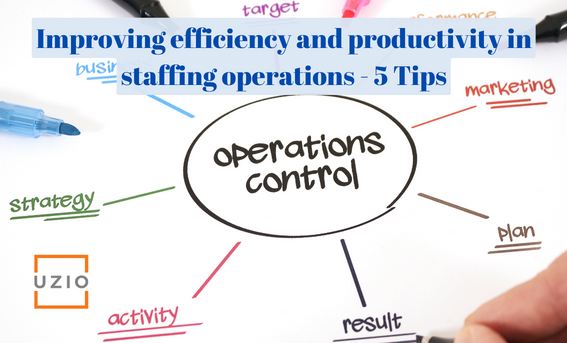
5 Tips for improving efficiency and productivity in Staffing Operations
Quick links
-
Introduction
-
Tip 1: Automate processes using technology
-
Tip 2: Develop a comprehensive staffing plan
-
Tip 3: Implement best practices for recruiting and hiring
-
Tip 4: Implement best practices for managing employees
-
Tip 5: Monitor and measure performance
-
Conclusion
Introduction
Efficiency and productivity are key factors in the success of any staffing agency. By streamlining processes and implementing best practices, staffing agencies can improve their bottom line and better serve their clients and candidates.
In this article, we will explore several tips for improving efficiency and productivity in staffing operations. These include automating processes, developing a comprehensive staffing plan, using technology, implementing best practices for recruiting, hiring, and managing employees, monitoring and measuring performance using KPIs.
1. Automate processes using technology
One of the most effective ways to improve efficiency and productivity in staffing operations is to automate as many processes as possible. Technology can be a powerful tool for improving efficiency and productivity in staffing operations. However, staffing agencies should be intentional in their use of technology and not automate just for the sake of automating.
Before staffing agencies make a decision to use technology for one operation or the other, they should start by first making a list of all the processes that are being done manually and are repetitive. Once the list is compiled, they should identify a solution that will automate as many of these processes as possible with one solution. Using different technology solutions for individual processes leaves a lot of work still to be done manually. Plus, agency employees have to log in to different systems, copy data from one system to another to accomplish a simple workflow.
For example, if you are using one system for ATS (Application Tracking System) and a different system for onboarding and payroll, you will need to manually move data of new hires from ATS to your payroll system. This is error-prone and inefficient. Ideally, you should look for one system that has ATS functionality as well as functionality for onboarding, payroll, etc. This will not only save time and reduce errors but also improve the overall user experience and make it more convenient for the employees.
Moreover, integrating workforce analytics software can yield invaluable insights into staffing operations, empowering agencies to make informed decisions regarding recruitment, resource allocation, and performance evaluation. This technological investment enables agencies to streamline workflows, pinpoint areas for enhancement, and optimize resource utilization effectively.
2. Develop a comprehensive staffing plan
Create a detailed staffing plan that outlines the specific roles and responsibilities of each position, as well as the qualifications and skills required for each role. This can help ensure that you have the right people in the right positions to meet your organization’s needs.
- Identify staffing needs: Conduct a thorough analysis of your organization’s current and future staffing needs. This should include an assessment of the number of employees needed, their roles and responsibilities, qualifications and skills required, and the projected timeline for filling open positions
- Determine job descriptions and qualifications: Develop detailed job descriptions for each position, outlining the specific duties, responsibilities, and qualifications required for the role. This will help ensure that you are recruiting the right candidates for each position
- Establish recruitment and hiring processes: Develop a recruitment and hiring process that includes steps such as posting job openings, screening resumes, conducting interviews, and making job offers. Establishing clear processes will help ensure that you are able to efficiently and effectively fill open positions
- Set goals and objectives: Establish specific, measurable goals and objectives for your staffing plan. This will help you track progress and make data-driven decisions about staffing levels and the effectiveness of your recruitment and hiring processes
- Allocate budget and resources: Allocate budget and resources to support your staffing plan, including recruiting and hiring expenses, employee training and development, and ongoing employee support
- Communicate the plan: Communicate the staffing plan to all relevant stakeholders, including management, employees, and external partners. This will help ensure that everyone understands the plan and is aware of their roles and responsibilities
- Review and update the plan: Regularly review and update your staffing plan to ensure it remains aligned with your organization’s goals and objectives and is responsive to changes in staffing needs and market conditions
3. Implement best practices for recruiting and hiring
Effective recruiting and hiring practices are crucial for staffing agencies.
Here are some best practices for recruitment and hiring that staffing agencies can use to improve their efficiency and productivity:
- Develop a strong employer brand: Creating a strong employer brand can help attract top talent to your agency. By highlighting your agency’s values, mission, and culture, you can make your agency more attractive to potential candidates
- Use targeted recruiting strategies: Instead of casting a wide net, focus on recruiting efforts on specific groups of candidates who are most likely to be a good fit for the positions you are trying to fill. For example, if you are recruiting for a specific industry, focus your efforts on networking and recruiting within that industry
- Create job postings that are clear and concise: Job postings that are well-written and easy to understand will attract more qualified candidates. Make sure your postings include clear information about the job duties, qualifications, and benefits
- Use social media and other online platforms: Social media and other online platforms can be a powerful tool for recruiting candidates. Use these platforms to promote your agency’s brand and job openings
- Conduct thorough background checks and reference checks: Before hiring a candidate, it’s important to conduct thorough background checks and reference checks to ensure that the candidate is a good fit for the position and for your agency
- Have a clear and consistent interview process: A clear and consistent interview process can help you evaluate candidates fairly and make informed hiring decisions
- Use pre-employment assessments: Pre-employment assessments such as skills tests and personality tests can help you identify candidates who are the best fit for the position
- Foster a positive candidate experience: The candidate experience is important, as it can impact the agency’s reputation and ability to attract top talent in the future. By treating candidates with respect and providing timely feedback, agencies can create a positive candidate experience
By using these best practices, staffing agencies can improve their recruitment and hiring process and attract the best candidates for the positions they are trying to fill.
4. Implement best practices for managing employees
Managing employees effectively is also key to improving efficiency and productivity in staffing operations. This includes:
- Clearly communicate expectations and job responsibilities to employees
- Provide regular performance evaluations and opportunities for feedback
- Encourage professional development and training
- Foster a positive and inclusive work environment
- Offer competitive compensation and benefits
- Implement fair and consistent disciplinary procedures
- Encourage open communication and address issues promptly
- Recognize and reward good performance
- Implement a system for tracking employee attendance and punctuality
- Create an open-door policy where employees feel comfortable approaching management with questions or concerns
5. Monitor and measure performance
Monitoring and measuring performance is essential for identifying areas where improvements can be made. There are several key performance indicators (KPIs) that staffing agencies can use to measure their performance and identify areas where improvements can be made. These include:
Time-to-fill:
This measures the amount of time it takes for a position to be filled from the time the job is posted. This is an important metric as it can indicate how effectively an agency is recruiting and hiring candidates.
Cost-per-hire:
This measures the total cost of filling a position, including recruiting and hiring expenses, divided by the number of hires. This can indicate the agency’s efficiency in recruiting and hiring candidates, and also help to identify areas for cost savings.
Placement rate:
This measures the number of candidates that are placed in job positions divided by the total number of candidates that are presented to clients. This can indicate the agency’s effectiveness in matching candidates with job positions and its ability to provide qualified candidates to its clients.
Billable hours:
This measures the number of hours worked by temporary employees that are billable to clients. This can indicate the agency’s effectiveness in utilizing its temporary workforce and its ability to generate revenue.
Employee retention rate:
This measures the number of employees that remain with the agency over a given period of time. This can indicate the agency’s effectiveness in retaining its employees and the level of satisfaction among its workforce.
Gross Margin:
This measures the profit the agency makes after deducting the cost of the temporary workforce from the revenue generated.
Sales Conversion rate:
This measures the percentage of leads that turn into clients.
Client Retention rate:
This measures the number of clients that remain with the agency over a given period of time. This can indicate the agency’s effectiveness in retaining its clients and the level of satisfaction among its client base.
By tracking these KPIs, staffing agencies can gain valuable insights into their performance and identify areas where improvements can be made. Additionally, they can benchmark themselves against industry standards and see how they are performing relative to their competitors.
Conclusion
Improving efficiency and productivity in staffing operations is essential for the success of any staffing agency. By automating processes, using technology, and implementing best practices for recruiting, hiring, and managing employees, agencies can improve their bottom line and better serve their clients and candidates. Additionally, monitoring and measuring performance can help agencies identify areas where improvements can be made.
Get in touch with us for an expert-led demo to know more about UZIO payroll services.





